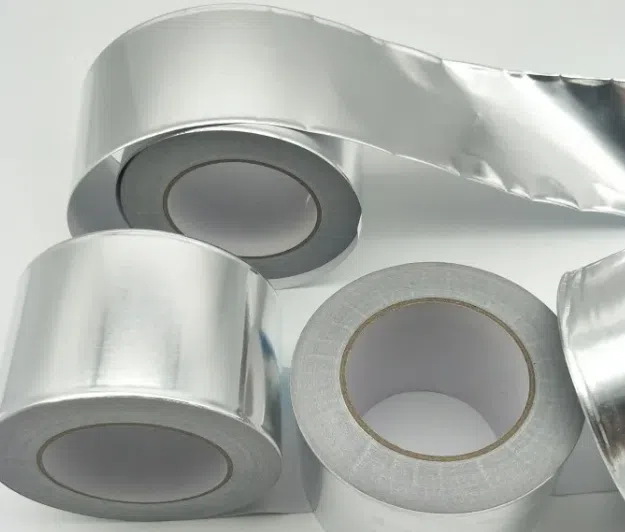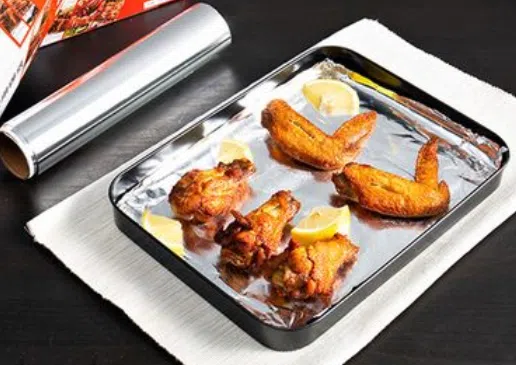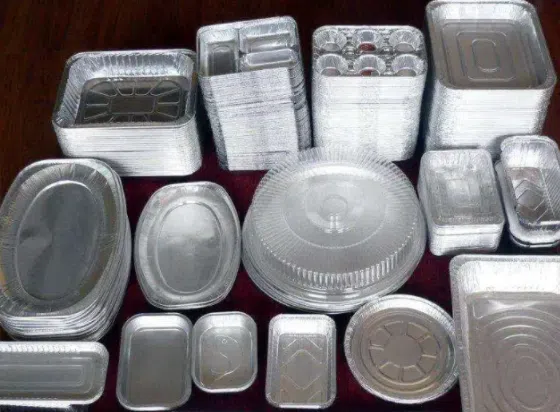Aluminum foil is a hot stamping material that is directly rolled from metal aluminum into thin sheets. Its hot stamping effect is similar to that of pure silver foil, so it is also called fake silver foil.


Due to the soft texture of aluminum, good ductility and silvery white luster, if the rolled sheet is mounted on offset paper with sodium silicate and other substances to make aluminum foil, it can also be printed.
However, the aluminum foil itself is easy to oxidize, the color becomes darker, and the color will fade when rubbed and touched, so it is not suitable for hot stamping on the cover of books and periodicals that have been preserved for a long time.
In the production of double foil, the rolling of aluminum foil is divided into three processes: rough rolling, intermediate rolling and finishing rolling.
From a technological point of view, it can be roughly divided from the thickness of the rolling outlet.
The general method is rough rolling with an outlet thickness greater than or equal to 0.05 mm, intermediate rolling with an outlet thickness of 0.013-0.05, and finishing rolling for single and double-rolled products with an outlet thickness less than 0.013 mm.
The rolling characteristics of rough rolling are similar to those of aluminum sheet and strip. Thickness control mainly depends on rolling force and post tension. The rough rolling ratio is very small, and its rolling characteristics are completely different from the rolling of aluminum sheet and strip.
It has the advantages of aluminum foil rolling. Its particularity, its characteristics are mainly reflected in the following aspects:
(1) Rolling of aluminum sheet and strip. The thinning of the aluminum strip mainly depends on the rolling force,so the automatic control method of plate thickness is the control method of AGC with a constant roll gap as the main body.
Even if the rolling force changes, the roll gap can be adjusted at any time to keep the roll gap at a certain value.
Sheets and strips of uniform thickness can be obtained. When the aluminum foil is rolled to the intermediate finishing rolling, due to the extremely thin thickness of the aluminum foil, the rolling force increases during rolling, which makes the elastic deformation of the roll easier than the plastic deformation of the rolled material, and the elastic flattening of the roll cannot be ignored.
The flattening of the spring determines that the rolling force can no longer play the role of rolling the sheet. It mainly depends on the adjusted tension and rolling speed.
(2) Rolling. For ultra-thin aluminum foil with a thickness of less than 0.012 mm (the thickness is related to the diameter of the work roll), it is difficult to use a single rolling method due to the elastic flattening of the roll,so the combined rolling method is adopted for double rolling.
The method of adding grease between two sheets of aluminum foil and rolling them together (also known as stacking).
Stacked rolling can not only roll out extremely thin aluminum foil that cannot be produced by single rolling, but also reduce the number of broken strips and improve labor productivity.
This process can mass produce single-sided smooth aluminum foil from 0.006 mm to 0.03 mm.
(3) Speed effect. In the process of aluminum foil rolling, the phenomenon that the thickness of aluminum foil decreases with the increase of rolling degree is called the speed effect. The mechanistic explanation of the velocity effect needs to be further studied. The reasons for the speed effect are generally believed to have the following three aspects:
1) The friction state between the work roll and the rolled material changes.
As the rolling speed increases, the amount of lubricating oil brought in increases, so that the lubrication state between the roll and the rolled material changes.
The coefficient of friction decreases, the oil film thickens, and the thickness of the aluminum foil decreases.
2), the change of the rolling mill itself. In rolling mills with cylindrical bearings, as the rolling speed increases, the roll necks will float in the bearings, causing the two interacting rolls to approach each other.
3) When the material is deformed by rolling, it is softened by processing. High-speed foil mills have very high rolling speeds.
With the increase of rolling speed, the temperature of rolling deformation zone increases.
After calculation, the metal temperature in the deformation zone can be increased to 200 °C, which is equivalent to intermediate recovery annealing, resulting in softening during rolling.
① Determination of total processing rate The total processing rate refers to the total deformation degree of the foil after recrystallization and annealing until the finished product is rolled. Generally speaking, the total processing rate of 1 series can reach more than 99%, and some 8 series products can also reach this value, but the total processing rate of aluminum alloy foil is generally below 90%.
② Determination of pass processing rate Determination of pass processing rate is the core of rolling process. In pure aluminum series products, the pass rate can reach 65%. The first pass after billet annealing should not be too large. The treatment rate is generally around 50%.
Rolling thickness
The thickness measurement methods of aluminum foil rolling mainly include eddy current thickness measurement, isotope ray thickness measurement and X-ray thickness measurement. X-ray thickness measurement is the most commonly used thickness measurement method in aluminum foil production, especially in high-speed foil mills. Thickness control method during aluminum foil rolling: rolling force control, tension control, rolling speed control, tension/speed, speed/tension control.
Because of its excellent performance, aluminum foil is widely used in food, beverage, cigarette, medicine, photographic plate, household daily necessities, etc., and is usually used as its packaging material; electrolytic capacitor material; insulation material for buildings, vehicles, ships, houses, etc.; also As decorative gold and silver thread, wallpaper and various stationery prints and decorative trademarks of light industrial products, etc.

Household aluminum foil is widely used in cooking, freezing, preservation, baking, etc.
The cable foil uses the air tightness and shielding properties of the aluminum foil to coat one or both sides with a plastic film as the shielding layer of the cable. The cable foil requires less oil on the surface, no holes, and high mechanical properties. The overall quality requirements are not high, but the length requirements are extremely strict. Common thickness: 0.007-0.2 mm
Air conditioner aluminum foil is a special material for manufacturing air conditioner heat exchanger fins. It is coated with an anti-corrosion inorganic coating and a hydrophilic organic coating before forming to form a hydrophilic foil, which is widely used in refrigeration equipment such as household industrial air conditioners, refrigerators, and automotive air conditioners. The thickness of the air conditioner foil is 0.07 mm~0.2 mm.
The aluminum foil for cigarettes is mainly used as the inner lining paper of the cigarette case after being compounded with the paper. The aluminum foil paper used as cigarette lining paper mainly includes rolled aluminum foil paper and aluminized paper. Aluminum foil can block moisture and effectively prevent moisture

Medicinal aluminum foil has the advantages of non-toxicity, corrosion resistance, water impermeability, heat resistance, moisture resistance, light resistance, high temperature sterilization, etc. It is mainly used for blister packaging of capsules, tablets, etc.

Flexible packaging aluminum foil, also known as conversion foil, flexible packaging is a bag-like container made of flexible composite packaging materials, which is widely used as a substrate for PE, PET and paper laminates for food packaging. Henan Henry can produce Alloy 8011, 8079 and 1235 flexible packaging foils as thin as 0.005 mm and as wide as 1850 mm.
Lithium battery aluminum foil is one of the basic materials for new energy vehicle lithium batteries. The lithium-ion battery industry usually uses rolled aluminum foil as the positive electrode current collector, and lithium battery aluminum foil is widely used as the positive electrode current collector for secondary lithium-ion batteries and super capacitors. The foil has excellent performance in battery manufacturing
Creams, liquids and powders come in user-friendly, safe and versatile packaging. Cold-formed aluminum foil has excellent barrier properties and completely excludes moisture, oxygen and other gases.
Decorative aluminum foil is a decorative material applied in the form of aluminum-plastic composite by utilizing the characteristics of good colorability and high light and heat reflectivity of aluminum foil. Mainly used for construction, furniture decoration and some gift box packaging.

Aluminum Foil For Food Container used for food utensils such as fast food restaurants, takeaway shops, high-end hotels, aviation tableware, home kitchens, etc. It has the characteristics of beautiful appearance, convenient use, safety and hygiene, and no odor pollution. Common specifications: 0.01-0.2 mm




QR Code
